Implications of Adopting Drip Irrigation System on Crop Yield and Gender-Sensitive Issues: The Case of Haramaya District, Ethiopia
Abstract
1. Introduction
2. Materials and Methods
Methodology
3. Results and Discussion
3.1. Respondent Characteristics
3.2. Farmland Characteristics
3.3. Irrigation Practices
3.4. Crop Water Productivity and Crop Yield
3.5. Farmers’ Perception on the Drip Irrigation and Self-Provided Water Supply Schemes
4. Conclusions and Recommendations
Author Contributions
Funding
Acknowledgments
Conflicts of Interest
References
- Sadoff, C. Managing Water Resources to Maximize Sustainable Growth: A World Bank Water Resources Assistance Strategy for Ethiopia; World Bank Publications: Washington, DC, USA, 2019. [Google Scholar]
- United Nations Department of Economic and Social Affairs. Population Division. World Population Prospects 2019: Highlights; United Nations Department of Economic and Social Affairs: New York, NY, USA, 2019. [Google Scholar]
- Changnon, S.A.; Pielke, R.A., Jr.; Changnon, D.; Sylves, R.T.; Pulwarty, R. Human factors explain the increased losses from weather and climate extremes. Bull. Am. Meteorol. Soc. 2000, 81, 437–442. [Google Scholar] [CrossRef]
- Elliott, J.; Deryng, D.; Müller, C.; Frieler, K.; Konzmann, M.; Gerten, D.; Glotter, M.; Flörke, M.; Wada, Y.; Best, N. Constraints and potentials of future irrigation water availability on agricultural production under climate change. Proc. Natl. Acad. Sci. USA 2014, 111, 3239–3244. [Google Scholar] [CrossRef]
- Easterling, D.R.; Meehl, G.A.; Parmesan, C.; Changnon, S.A.; Karl, T.R.; Mearns, L.O. Climate extremes: Observations, modeling, and impacts. Science 2000, 289, 2068–2074. [Google Scholar] [CrossRef] [PubMed]
- Burnham, M.; Ma, Z. Linking smallholder farmer climate change adaptation decisions to development. Clim. Dev. 2016, 8, 289–311. [Google Scholar] [CrossRef]
- Haddeland, I.; Heinke, J.; Biemans, H.; Eisner, S.; Flörke, M.; Hanasaki, N.; Konzmann, M.; Ludwig, F.; Masaki, Y.; Schewe, J. Global water resources affected by human interventions and climate change. Proc. Natl. Acad. Sci. USA 2014, 111, 3251–3256. [Google Scholar] [CrossRef]
- Morea, D.; Balzarini, M. Financial sustainability of a public-private partnership for an agricultural development project in Sub-Saharan Africa. Agric. Econ. 2018, 64, 389–398. [Google Scholar]
- Nelson, G.C.; Rosegrant, M.W.; Koo, J.; Robertson, R.; Sulser, T.; Zhu, T.; Ringler, C.; Msangi, S.; Palazzo, A.; Batka, M. Climate Change: Impact on Agriculture and Costs of Adaptation; International Food Policy Research Institute: Washington, DC, USA, 2009; Volume 21. [Google Scholar]
- Teklewold, H.; Mekonnen, A.; Kohlin, G.; Di Falco, S. Does adoption of multiple climate-smart practices improve farmers’climate resilience? Empirical evidence from the nile basin of ethiopia. Clim. Chang. Econ. 2017, 8, 1750001. [Google Scholar] [CrossRef]
- Food and Agriculture Organization of the United Nations. Country Gender Assessment: Ethiopia; Food and Agriculture Organization of the United Nations: Rome, Italy, 2019. [Google Scholar]
- Meze-Hausken, E. Contrasting climate variability and meteorological drought with perceived drought and climate change in northern Ethiopia. Clim. Res. 2004, 27, 19–31. [Google Scholar] [CrossRef]
- Mishra, A.K.; Singh, V.P. A review of drought concepts. J. Hydrol. 2010, 391, 202–216. [Google Scholar] [CrossRef]
- Machado Mendes, D.; Paglietti, L. Ethiopia: Irrigation Market Brief; Food and Agriculture Organization of the United Nations: Rome, Italy, 2015. [Google Scholar]
- Awulachew, S.B.; Merrey, D.; Kamara, A.; Van Koppen, B.; de Vries, F.P.; Boelee, E. Experiences and Opportunities for Promoting Small-Scale/Micro Irrigation and Rainwater Harvesting for Food Security in Ethiopia; International Water Management Institute: Colombo, Sri Lanka, 2005; Volume 98. [Google Scholar]
- Riar, A.; Mandloi, L.S.; Poswal, R.S.; Messmer, M.M.; Bhullar, G.S. A diagnosis of biophysical and socio-economic factors influencing farmers’ choice to adopt organic or conventional farming systems for cotton production. Front. Plant Sci. 2017, 8, 1289. [Google Scholar] [CrossRef]
- Steuer, R.E.; Na, P. Multiple criteria decision making combined with finance: A categorized bibliographic study. Eur. J. Oper. Res. 2003, 150, 496–515. [Google Scholar] [CrossRef]
- Morea, D.; Balzarini, M. Bankability of a public private partnership in agricultural sector: A project in Sub Saharan Africa. Agric. Econ. 2019, 65, 212–222. [Google Scholar] [CrossRef]
- Kløve, B.; Ala-Aho, P.; Bertrand, G.; Gurdak, J.J.; Kupfersberger, H.; Kværner, J.; Muotka, T.; Mykrä, H.; Preda, E.; Rossi, P.M. Climate change impacts on groundwater and dependent ecosystems. J. Hydrol. 2014, 518, 250–266. [Google Scholar] [CrossRef]
- Andersson, L.; Samuelsson, P.; Kjellström, E. Assessment of climate change impact on water resources in the Pungwe river basin. Tellus A 2011, 63, 138–157. [Google Scholar] [CrossRef]
- Bailey, R.T.; Wible, T.C.; Arabi, M.; Records, R.M.; Ditty, J. Assessing Regional-Scale Spatio-Temporal Patterns of Groundwater-Surface Water Interactions using a Coupled SWAT-MODFLOW model. Hydrol. Process. 2016, 30, 4420–4433. [Google Scholar] [CrossRef]
- Treidel, H.; Martin-Bordes, J.L.; Gurdak, J.J. Climate Change Effects on Groundwater Resources: A Global Synthesis of Findings and Recommendations; CRC Press: Boca Raton, FL, USA, 2011. [Google Scholar]
- Keane, J.; Page, S.; Kennan, J. Climate Change and Developing Country Agriculture; International Centre for Trade and Sustainable Development: Geneva, Switzerland, 2009. [Google Scholar]
- Green, T.R.; Taniguchi, M.; Kooi, H.; Gurdak, J.J.; Allen, D.M.; Hiscock, K.M.; Treidel, H.; Aureli, A. Beneath the surface of global change: Impacts of climate change on groundwater. J. Hydrol. 2011, 405, 532–560. [Google Scholar] [CrossRef]
- Strzepek, K.M.; McCluskey, A. The Impacts of Climate Change on Regional Water Resources and Agriculture in Africa; World Bank Publications: Washington, DC, USA, 2007; Volume 4290. [Google Scholar]
- Deressa, T.; Hassan, R.M.; Ringler, C. Measuring Ethiopian Farmers’ Vulnerability to Climate Change across Regional States; International Food Policy Research Institute: Washington, DC, USA, 2008. [Google Scholar]
- Brauman, K.A.; Siebert, S.; Foley, J.A. Improvements in crop water productivity increase water sustainability and food security—A global analysis. Environ. Res. Lett. 2013, 8, 024030. [Google Scholar] [CrossRef]
- Knox, J.; Kay, M.; Weatherhead, E. Water regulation, crop production, and agricultural water management—Understanding farmer perspectives on irrigation efficiency. Agric. Water Manag. 2012, 108, 3–8. [Google Scholar] [CrossRef]
- Ogato, G.S.; Boon, E.K.; Subramani, J. Improving access to productive resources and agricultural services through gender empowerment: A case study of three rural communities in Ambo District, Ethiopia. J. Human Ecol. 2009, 27, 85–100. [Google Scholar] [CrossRef]
- Ambaw, G.; Tadesse, M.; Mungai, C.; Kuma, S.; Radeny, M.; Tamene, L.; Solomon, D. Gender Assessment for Women’s Economic Empowerment in Doyogena Climate-Smart Landscape in Southern Ethiopia; CGIAR Research Program on Climate Change, Agriculture and Food Security: Wageningen, The Netherlands, 2019. [Google Scholar]
- Debela, N.; Mohammed, C.; Bridle, K.; Corkrey, R.; McNeil, D. Perception of climate change and its impact by smallholders in pastoral/agropastoral systems of Borana, South Ethiopia. SpringerPlus 2015, 4, 236. [Google Scholar] [CrossRef]
- Villani, L.; Castelli, G.; Hagos, E.Y.; Bresci, E. Water productivity analysis of sand dams irrigation farming in northern Ethiopia. J. Agric. Environ. Int. Dev. 2018, 112, 139–160. [Google Scholar]
- Castelli, G.; Bresci, E.; Castelli, F.; Hagos, E.Y.; Mehari, A. A participatory design approach for modernization of spate irrigation systems. Agric. Water Manag. 2018, 210, 286–295. [Google Scholar] [CrossRef]
- Awulachew, S.B.; Ahmed, A.; Haileselassie, A.; Yilma, A.D.; Bashar, K.; McCartney, M.P.; Steenhuis, T. Improved Water and Land Management in the Ethiopian Highlands and Its Impact on Downstream Stakeholders Dependent on the Blue Nile; International Livestock Research Institute: Nairobi, Kenya, 2010. [Google Scholar]
- Azadi, H.; De Rudder, F.; Vlassenroot, K.; Nega, F.; Nyssen, J. Targeting international food aid programmes: The case of productive safety net programme in Tigray, Ethiopia. Sustainability 2017, 9, 1716. [Google Scholar] [CrossRef]
- Aldababseh, A.; Temimi, M.; Maghelal, P.; Branch, O.; Wulfmeyer, V. Multi-criteria evaluation of irrigated agriculture suitability to achieve food security in an arid environment. Sustainability 2018, 10, 803. [Google Scholar] [CrossRef]
- Dile, Y.T.; Rockström, J.; Karlberg, L. Suitability of water harvesting in the Upper Blue Nile Basin, Ethiopia: A first step towards a mesoscale hydrological modeling framework. Adv. Meteorol. 2016, 2016, 5935430. [Google Scholar] [CrossRef]
- Imburgia, L. Irrigation and equality: An integrative gender-analytical approach to water governance with examples from Ethiopia and Argentina. Water Altern. 2019, 12, 571–587. [Google Scholar]
- Tsige, M. Who Benefits from Production Outcomes? Gendered Production Relations among Climate-Smart Agriculture Technology Users in Rural Ethiopia. Rural Sociol. 2019, 84, 799–825. [Google Scholar] [CrossRef]
- Arora, D.; Rada, C. Gender differences in time and resource allocation in rural households in Ethiopia. In Proceedings of the Annual Conference of the American Economic Association, San Diego, CA, USA, 4–6 January 2013. [Google Scholar]
- Austin, A.T.; Vitousek, P. Nutrient dynamics on a precipitation gradient in Hawaii. Oecologia 1998, 113, 519–529. [Google Scholar] [CrossRef]
- Chamberlin, J.; Schmidt, E. Ethiopian agriculture: A dynamic geographic perspective. Food Agric. Ethiop. 2012, 17, 21–52. [Google Scholar]
- Awulachew, S.B. Modelling natural conditions and impacts of consumptive water use and sedimentation of Lake Abaya and Lake Chamo, Ethiopia. Lakes Reserv. 2006, 11, 73–82. [Google Scholar] [CrossRef]
- Ministry of Finance and Economic Development. Building on Progress A Plan for Accelerated and Sustained Development to End Poverty (PASDEP); Ministry of Finance and Economic Development: Addis Ababa, Ethiopia, 2006; Volume 1.
- Khairo, S.; Battese, G.E.; Mullen, J. Agriculture, food insecurity and agricultural policy in Ethiopia. Outlook Agric. 2005, 34, 77–82. [Google Scholar] [CrossRef]
- Zewdie, M.C.; Van Passel, S.; Moretti, M.; Annys, S.; Tenessa, D.B.; Ayele, Z.A.; Tsegaye, E.A.; Cools, J.; Minale, A.S.; Nyssen, J. Pathways how irrigation water affects crop revenue of smallholder farmers in northwest Ethiopia: A mixed approach. Agric. Water Manag. 2020, 233, 106101. [Google Scholar] [CrossRef]
- Johnson, N.L.; Kovarik, C.; Meinzen-Dick, R.; Njuki, J.; Quisumbing, A. Gender, assets, and agricultural development: Lessons from eight projects. World Dev. 2016, 83, 295–311. [Google Scholar] [CrossRef]
- Jovanovic, N.; Musvoto, C.; De Clercq, W.; Pienaar, C.; Petja, B.; Zairi, A.; Hanafi, S.; Ajmi, T.; Mailhol, J.C.; Cheviron, B. A comparative analysis of yield gaps and water productivity on smallholder farms in Ethiopia, South Africa and Tunisia. Irrig. Drain. 2020, 69, 70–87. [Google Scholar] [CrossRef]
- Araya, T.; Nyssen, J.; Govaerts, B.; Deckers, J.; Cornelis, W.M. Impacts of conservation agriculture-based farming systems on optimizing seasonal rainfall partitioning and productivity on vertisols in the Ethiopian drylands. Soil Tillage Res. 2015, 148, 1–13. [Google Scholar] [CrossRef]
- Nakawuka, P.; Langan, S.; Schmitter, P.; Barron, J. A review of trends, constraints and opportunities of smallholder irrigation in East Africa. Glob. Food Secur. 2018, 17, 196–212. [Google Scholar] [CrossRef]
- Awulachew, S.B.; Yilma, A.D.; Loulseged, M.; Loiskandl, W.; Ayana, M.; Alamirew, T. Water Resources and Irrigation Development in Ethiopia; International Water Management Institute: Colombo, Sri Lanka, 2007; Volume 123. [Google Scholar]
- Grum, B.; Assefa, D.; Hessel, R.; Woldearegay, K.; Ritsema, C.J.; Aregawi, B.; Geissen, V. Improving on-site water availability by combining in-situ water harvesting techniques in semi-arid Northern Ethiopia. Agric. Water Manag. 2017, 193, 153–162. [Google Scholar] [CrossRef]
- Farjad, B.; Pooyandeh, M.; Gupta, A.; Motamedi, M.; Marceau, D. Modelling Interactions between Land Use, Climate, and Hydrology along with Stakeholders’ Negotiation for Water Resources Management. Sustainability 2017, 9, 2022. [Google Scholar] [CrossRef]
- Hagos, F.; Makombe, G.; Namara, R.E.; Awulachew, S.B. Importance of Irrigated Agriculture to the Ethiopian Economy: Capturing the Direct Net Benefits of Irrigation; International Water Management Institute: Colombo, Sri Lanka, 2009; Volume 128. [Google Scholar]
- Makombe, G.; Namara, R.E.; Awulachew, S.B.; Hagos, F.; Ayana, M.; Kanjere, M. An analysis of the productivity and technical efficiency of smallholder irrigation in Ethiopia. Water SA 2017, 43, 48–57. [Google Scholar] [CrossRef]
- Tadesse, N.; Bheemalingeswara, K.; Abdulaziz, M. Hydrogeological investigation and groundwater potential assessment in Haromaya watershed, Eastern Ethiopia. Momona Ethiop. J. Sci. 2010, 2. [Google Scholar] [CrossRef]
- Tian, Y.; Zheng, Y.; Wu, B.; Wu, X.; Liu, J.; Zheng, C. Modeling surface water-groundwater interaction in arid and semi-arid regions with intensive agriculture. Environ. Model. Softw. 2015, 63, 170–184. [Google Scholar] [CrossRef]
- Alwan, I.A.; Karim, H.H.; Aziz, N.A. Groundwater aquifer suitability for irrigation purposes using multi-Criteria decision approach in Salah Al-Din Governorate/Iraq. AgriEngineering 2019, 1, 303–323. [Google Scholar] [CrossRef]
- Brouwer, C.; Prins, K.; Heibloem, M. Irrigation Water Management: Irrigation Scheduling; Food and Agriculture Organization of the United Nations: Rome, Italy, 1989. [Google Scholar]
- Pereira, L.S.; Oweis, T.; Zairi, A. Irrigation management under water scarcity. Agric. Water Manag. 2002, 57, 175–206. [Google Scholar] [CrossRef]
- Perry, C. Improving Irrigation Management in Conditions of Scarcity: Myth vs Truth; Global Water Forum: Brasilia, Brazil, 2018. [Google Scholar]
- Setegn, S.G.; Chowdary, V.; Mal, B.; Yohannes, F.; Kono, Y. Water balance study and irrigation strategies for sustainable management of a tropical Ethiopian lake: A case study of Lake Alemaya. Water Resour. Manag. 2011, 25, 2081–2107. [Google Scholar] [CrossRef]
- Muleta, S.; Yohannes, F.; Rashid, S. Soil erosion assessment of Lake Alemaya catchment, Ethiopia. Land Degrad. Dev. 2006, 17, 333–341. [Google Scholar] [CrossRef]
- Meshesha, D.T.; Tsunekawa, A.; Tsubo, M.; Ali, S.A.; Haregeweyn, N. Land-use change and its socio-environmental impact in Eastern Ethiopia’s highland. Reg. Environ. Chang. 2014, 14, 757–768. [Google Scholar] [CrossRef]
- Stillhardt, B.; Ghebru, B.; Mehari, A. Small-Scale Micro Irrigation in Eritrea: A Feasibility Study on the Introduction of Affordable Micro Irrigtion Technology in Eritrea, Environmend (CDE); University of Bern: Bern, Switzerland, 2003. [Google Scholar]
- Wakeyo, M.B.; Gardebroek, C. Share of irrigated land and farm size in rainwater harvesting irrigation in Ethiopia. J. Arid Environ. 2017, 139, 85–94. [Google Scholar] [CrossRef]
- Rockström, J.; Falkenmark, M. Agriculture: Increase water harvesting in Africa. Nature 2015, 519, 283–285. [Google Scholar] [CrossRef]


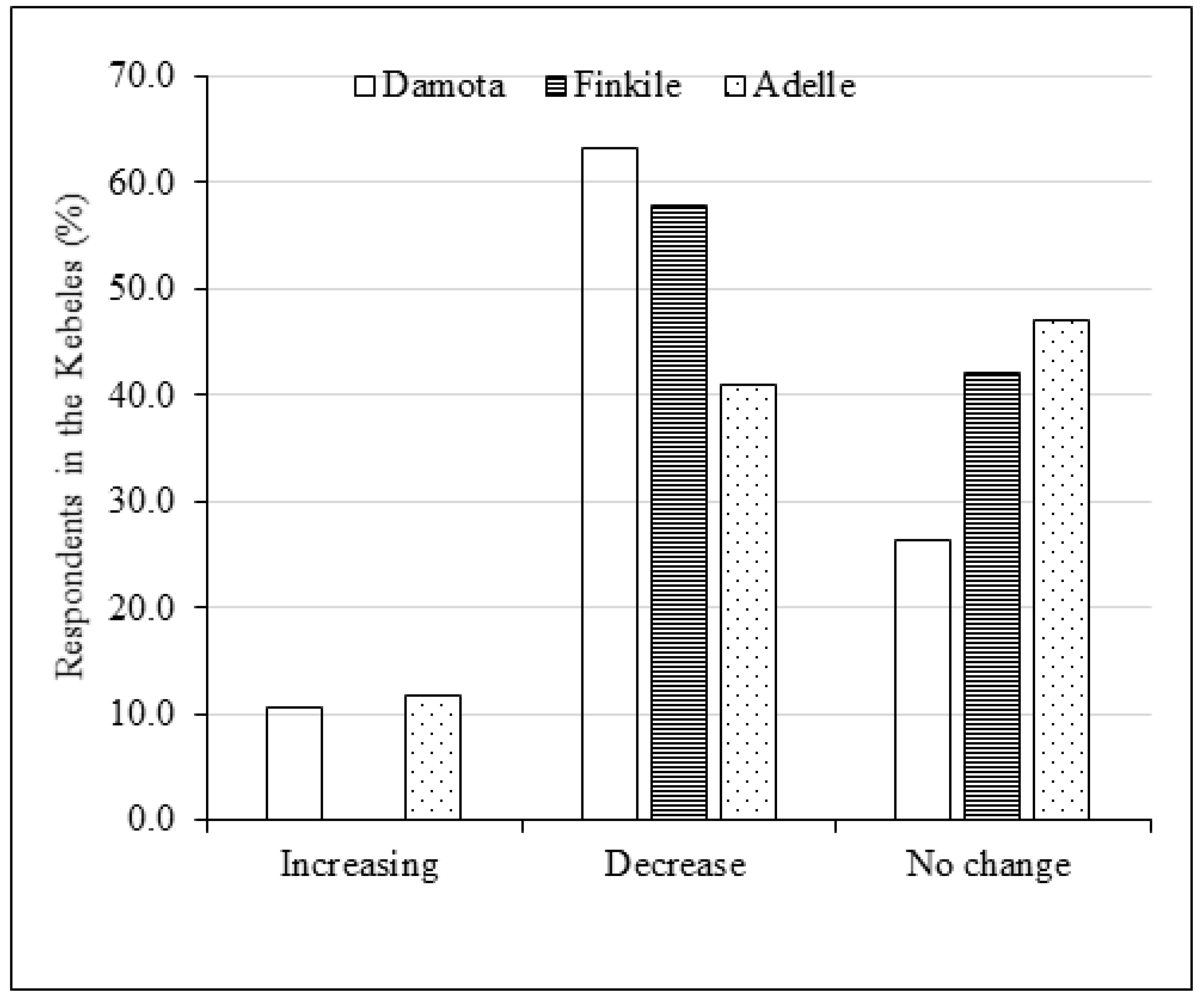
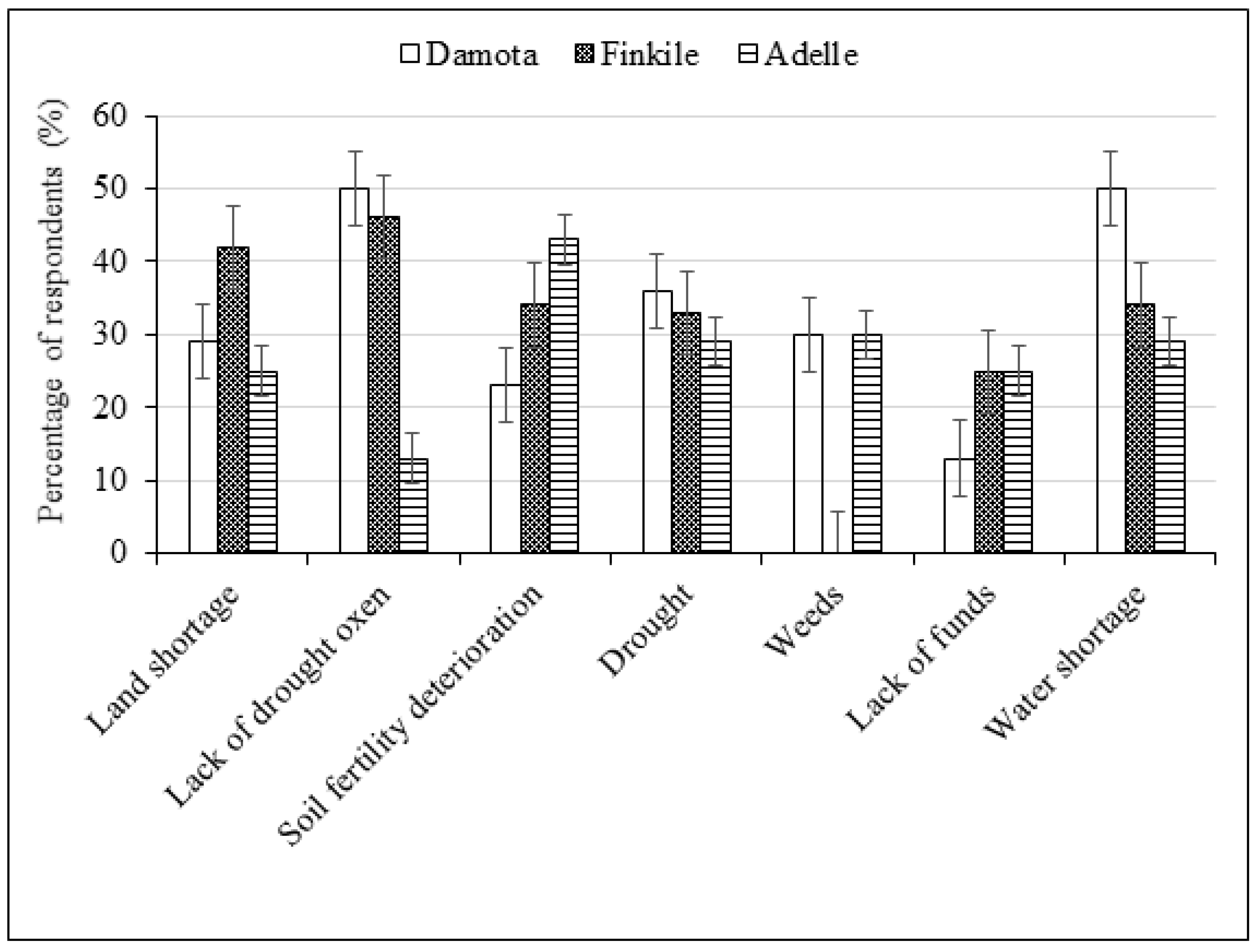
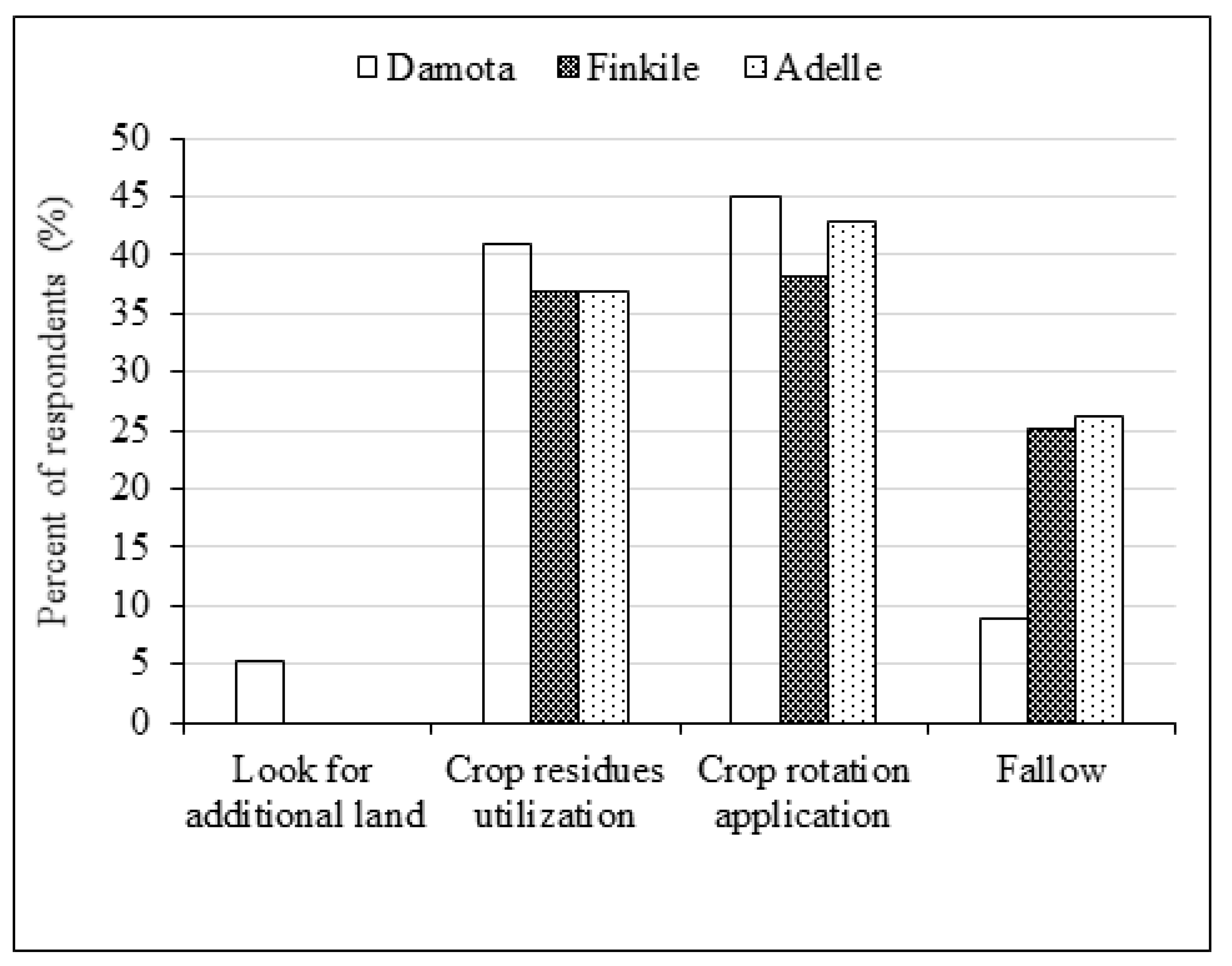
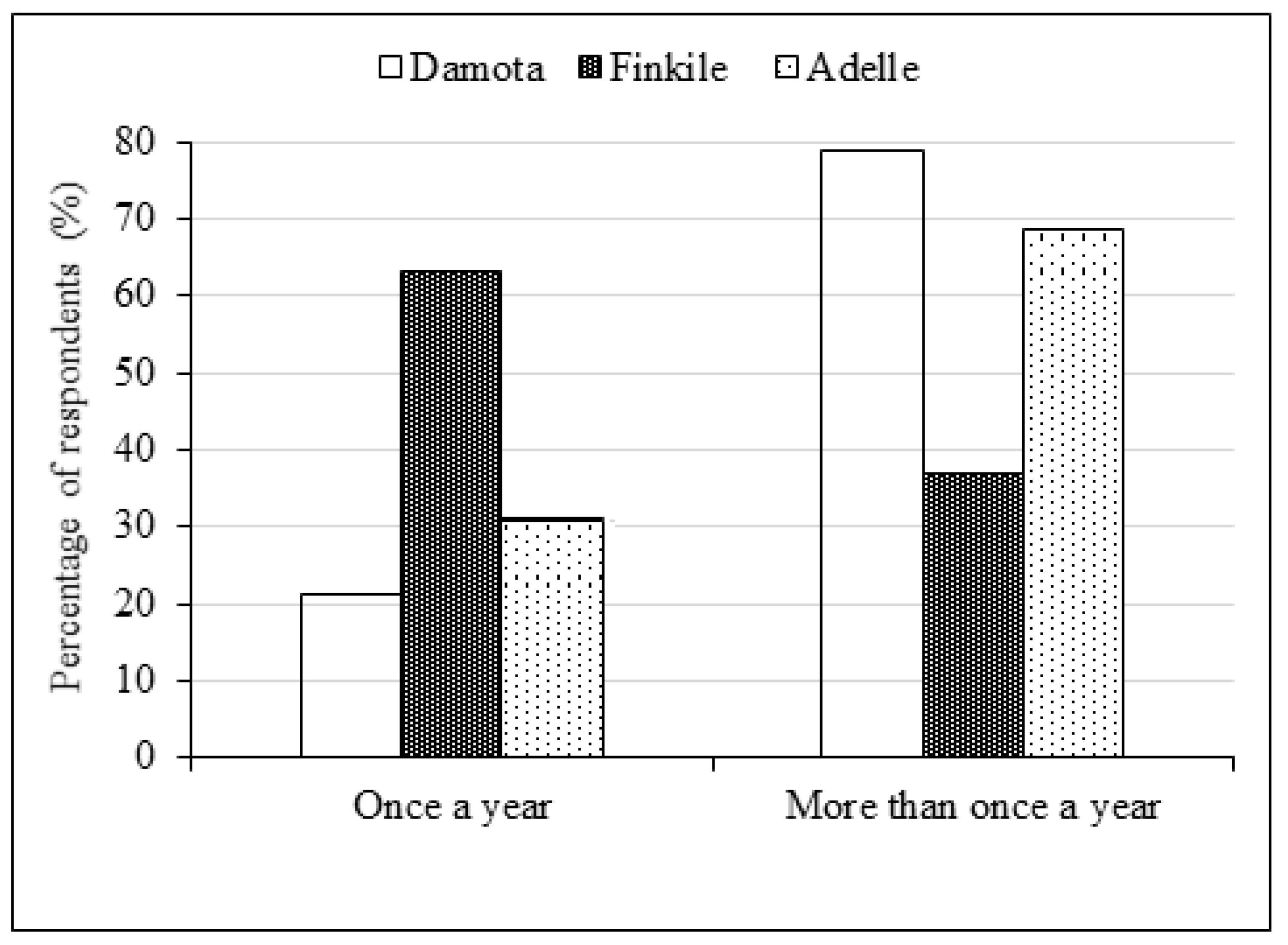
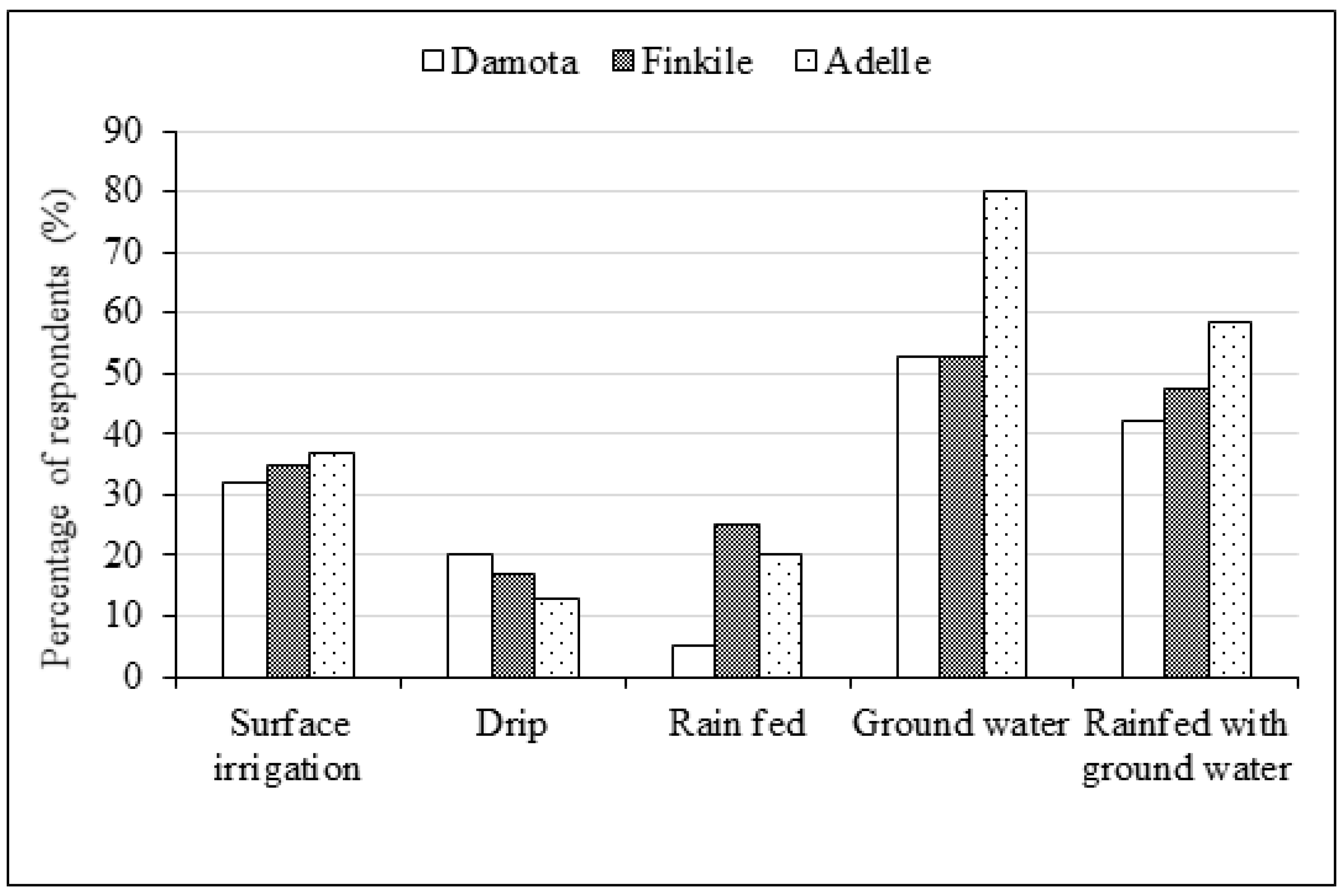



| Kebele | Number of Smallhold Farmers |
|---|---|
| Damota | 4 |
| Finkile | 3 |
| Adelle | 3 |
| Total | 10 |
| Kebele | Intervention Smallholder Farmers | Non-Intervention Smallholder Farmers | Total Farmers |
|---|---|---|---|
| Damota | 4 | 16 | 20 |
| Finkile | 3 | 17 | 20 |
| Adelle | 3 | 17 | 20 |
© 2020 by the authors. Licensee MDPI, Basel, Switzerland. This article is an open access article distributed under the terms and conditions of the Creative Commons Attribution (CC BY) license (http://creativecommons.org/licenses/by/4.0/).
Share and Cite
Dawit, M.; Dinka, M.O.; Leta, O.T. Implications of Adopting Drip Irrigation System on Crop Yield and Gender-Sensitive Issues: The Case of Haramaya District, Ethiopia. J. Open Innov. Technol. Mark. Complex. 2020, 6, 96. https://doi.org/10.3390/joitmc6040096
Dawit M, Dinka MO, Leta OT. Implications of Adopting Drip Irrigation System on Crop Yield and Gender-Sensitive Issues: The Case of Haramaya District, Ethiopia. Journal of Open Innovation: Technology, Market, and Complexity. 2020; 6(4):96. https://doi.org/10.3390/joitmc6040096
Chicago/Turabian StyleDawit, Meseret, Megersa Olumana Dinka, and Olkeba Tolessa Leta. 2020. "Implications of Adopting Drip Irrigation System on Crop Yield and Gender-Sensitive Issues: The Case of Haramaya District, Ethiopia" Journal of Open Innovation: Technology, Market, and Complexity 6, no. 4: 96. https://doi.org/10.3390/joitmc6040096
APA StyleDawit, M., Dinka, M. O., & Leta, O. T. (2020). Implications of Adopting Drip Irrigation System on Crop Yield and Gender-Sensitive Issues: The Case of Haramaya District, Ethiopia. Journal of Open Innovation: Technology, Market, and Complexity, 6(4), 96. https://doi.org/10.3390/joitmc6040096






